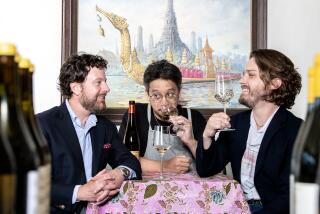By riverboat, to age-old Asia
We were passengers on a shore excursion on a luxury cruise, but, for the moment, we were not in the lap of luxury. We were climbing 70 jagged stairs in stark interior darkness in our bare feet, as Buddhist custom requires, to the top of a 12th century pagoda to watch the sun set over 2,000 ancient temples and the Irrawaddy River.
We had chosen, despite appearances, a very easy way to visit a very difficult place. There are no ATMs in what used to be Burma, and credit cards and traveler’s checks are not accepted. Public transportation is uncomfortable and unreliable. Few people speak English.
We were passengers on the Road to Mandalay, a 333-foot-long vessel owned by Orient-Express, the British company that runs posh trains in Europe and Asia. The gleaming white ship, fitted with teak, brass and marble and filled with Burmese antiques and vivid friezes, has been plying the Irrawaddy for eight years. Orient-Express bought it in 1994, when it was a floating hotel on the Rhine, and refitted it, tearing out 98 small cabins to create 66 large and extra-large staterooms, all with picture windows. Standard rooms cost $2,500 per person, with no single surcharge, for a four-day cruise; larger rooms cost $3,500 per person.
The Road to Mandalay sails upriver from Bagan, the nation’s spiritual heart, every Saturday. Four days later, it moors at the sacred walled city of Mandalay, having sailed 128 of the river’s 1,302 miles.
The Irrawaddy is fed by two crystal-clear streams in the Himalayas, picking up silt until it becomes a dark chocolate waterway bordered by steep, sandy banks, and finally plunging into the Andaman Sea. In the dry season, when I sailed, the river is a mile wide, shallow and filled with treacherous sandbars. During the summer monsoons, it rises 40 feet, overflows its banks and can measure up to four miles across.
The 57 passengers on my cruise were divided for shore excursions by language, 18 on the English tours and about 30 on the German ones. The rest of the passengers — Russians, Canadians and Belgians — had arranged for a private van. The English bus held five Americans, three French couples, a Chinese couple, a British couple and a German family who took the English bus because the German bus was too crowded.
We visited temples, pagodas and stupas and walked through markets unchanged since medieval days. We watched monks and their tiny novices in rust-colored robes line up for food at a village the ship had adopted. We sailed in rowboats under a spectacular mile-long teak footbridge and climbed endless staircases for unforgettable views.
Myanmar’s distance from the modern world was evident at every turn. Few people wore shoes. Women and children painted their cheeks with thanaka, a bark paste they believe protects them from the sun. Trousers were rare; men and women wore lungis, sarongs tucked in at the waist. In village markets, old women in purple and gold headscarves sat cross-legged on rattan mats, smoking cheroots and selling beans and peppers. Frazzled mothers with children tugging at their lungis haggled over bloody pig livers and rat carcasses.
Every aspect of Burmese life is pervaded by Buddhism. In Bagan, the belief that the faithful would enter Nirvana more quickly if they built holy places led to the construction of 4,446 shrines by the end of the 13th century. More than 2,000 survive. The temples of Myanmar have been repainted and regilded, and they’re filled with worshippers. In this nation where the average wage is less than $20 a month, people dressed in rags buy gold leaf at $1 per booklet to paste on statues of Buddha already heaped with gold. We visited a gold leaf factory and watched pale 10-year-old girls at work, their lives dedicated to separating gold leaf into pages for the devout.
Like clockwork
Life was good on board the Road to Mandalay. Before dawn, we rose to watch the sunrise on the pool deck, and cheerful members of the 70-person service crew brought us coffee and tea. Each day, we found fresh orchids in our rooms. I heard “Good morning, sir” more times during those four days than I’ve ever heard before.
We were taken on morning and afternoon excursions, all of which ran like clockwork. We always arrived at our sunset destination precisely 20 minutes before sunset. Local children surrounded us to practice their English as we were touring, and none begged for money. If they were selling postcards or fans, we bought them for a dollar or two. The kids were a highlight of our shore excursions.
Simon Griffiths, a British village locksmith, was our Pied Piper. “All the pretty girls are flocking to Simon,” said his wife, Lindsey, a railroad executive. “They don’t fancy him like this at home.” We tipped the kids for small favors, such as showing us to the loo or guarding our shoes at temple entrances.
Breakfast was served in a glassed-in dining room with teak ceiling beams and rattan furniture. The menu offered eggs Benedict, eggs Florentine and smoked salmon with chives. Breads, rolls, cakes, cereal and fresh tropical fruit were on a buffet table.
Lunches were ethnic buffets — Chinese, Indian, Lao and Burmese. The Belgian chef and the German sous-chef stood at the buffet to tell us what everything was. The Indian buffet, which I thought was the best, included plump, crispy samosas filled with potatoes and onions plus fragrant chicken korma and lamb rogan josh. Vegetables, seasoned with turmeric and coriander, included eggplant, cauliflower and carrots.
Dinners consisted of four courses with entrées such as lobster, marinated butterfish and regional dishes like laksa — prawns, chicken and noodles in a rich sauce of coconut cream, garlic and ginger. Beer and soft drinks were free. Wines, mostly French and Australian, began at $22. Many of us gathered in the piano bar before dinner as well as after. There was evening entertainment on the pool deck — acrobatics, puppet shows and Burmese folk music.
On our second night, hundreds of green, orange and white lanterns filled the Irrawaddy on both sides of the ship as Burmese rivermen welcomed us. Thousands of stars lighted the skies, and it would have been romantic if I’d been accompanied by my wife, who doesn’t travel off the beaten track.
Tina Arnold, a motivational consultant from Phoenix, saw things differently. “Nothing can be romantic when you know people around you are suffering, with an oppressive military government and massacres and forced labor,” she said.
The nation’s campaign to build a tourist industry like that of neighboring Thailand has been crippled by U.S. and European trade sanctions against the ruling military junta and an ensuing tourist boycott. Tourism received another blow last year when President Bush signed a bill that banned the export of financial services to Myanmar and thus brought credit card use to an end. Visitors like us must carry wads of cash, but credit cards are still good on the Road to Mandalay.
Last year, the Myanmar embassy in Washington issued 6,300 tourist visas to Americans, while more than 250,000 American tourists visited Thailand.
Fewer than half the Road to Mandalay’s 118 passenger beds were occupied during my cruise. John Hinchliffe, Orient-Express’ chief of Myanmar operations and the boss of the ship, blamed the tourist boycott. He said it hurt the people, not the ruling generals. “We employ 150 people. Without us, where would they go?” He said the ship built a clinic and a school in the village of Shwe Kyet Yet, stocked the school with books and fed monks.
Studying contrasts
Griffiths said he didn’t feel guilty about taking the cruise. “Absolutely not. I may have if there had appeared to be any resentment from the locals, but they were all so pleased to see us that I think they would probably be worse off without us there to spend a dollar or two.”
Lewis Lau, an IBM executive from Hong Kong, said he and his wife, Teresa, felt “sadness and helplessness” as they ate one elaborate supper on fine china while looking out the window at a family of four, squatting on a sand bank, making do with a bowl of rice.
On the last night of the cruise, the seven American and British passengers were invited to join our urbane captain, Ba Nyan, for drinks and dinner. Hinchliffe was our host in the piano bar.
By the time we hit the dinner table, we were in a good mood. Drinks were on the house. We enjoyed scallops and Caesar salad and steak and vegetable coulis, a cheese plate with blueberries, and a rich, layered white cake in honor of the chief engineer’s birthday. Everyone sang “Happy Birthday.” Hinchliffe, a veteran British mariner of considerable personal dignity, followed with his impression of actor Gabby Hayes.
Even though we were moored in Mandalay, no one dared sing the barroom ditty fashioned from Rudyard Kipling’s poem “Mandalay,” which gave the ship its name.
Kipling never set foot in Mandalay. He just liked the sound of the name. After this cruise, I’m pretty fond of the name too.
*
(BEGIN TEXT OF INFOBOX)
Finding your way to Myanmar
GETTING THERE:
From LAX to Yangon, connecting flights (change of planes) are available on Thai Airways. Restricted round-trip fares are $1,040.
TELEPHONES:
To call Myanmar numbers from the U.S., dial 011 (the international dialing code), 95 (country code for Myanmar), 1 for Yangon or 2 for Mandalay, and the local number.
CRUISES:
Road to Mandalay, Orient-Express, 10 Weybosset St., Suite 500, Providence, RI 02903; (866) 674-3689 or (401) 351-7518, https://www.orient-express.com . Singles and doubles for four-night cruises, from $2,480 per person. Runs from July to April. Price does not include air between Yangon and Bagan ($181) or between Mandalay and Yangon ($191).
Pandaw Cruises, Irrawaddy Flotilla Co., third floor, executive suite, Kandawgyi Palace Hotel, Kan Yeik Tha Road, Yangon, Myanmar; 249255-9, Ext. 5302 or 5307, https://www.pandaw.com . Singles for four-night cruises, from $1,200; doubles, from $800 per person. Runs from November to April. Price does not include air between Yangon and Bagan ($181) or between Mandalay and Yangon ($191).
WHEN TO GO:
The cool season, with daytime highs in the 70s and 80s, runs from October through January. Temperatures can reach the high 90s from February through mid-May. The rainy season, with occasional monsoons, begins in mid-May and ends in September.
VISAS:
U.S. citizens must obtain visas for travel to Myanmar. Tourist visas cost $20 and are valid for 28 days. Applications must be accompanied by two passport-sized photos and a statement of itinerary from the cruise operator and may be obtained from the Embassy of Myanmar, visa section, 2300 S St., NW, Washington, D.C., 20008; (202) 332-9044. U.S. passport must be valid for six months beyond the intended stay.
TO LEARN MORE:
Myanmar Tourism Promotion Board, Traders Hotel, Level 3, Business Centre, 223 Sule Pagoda Road, Yangon, Myanmar; 242-828, Ext. 6462, https://www.myanmartourism.com .
Comments? Email travel-feedback@latimes.com
More to Read
Sign up for The Wild
We’ll help you find the best places to hike, bike and run, as well as the perfect silent spots for meditation and yoga.
You may occasionally receive promotional content from the Los Angeles Times.






